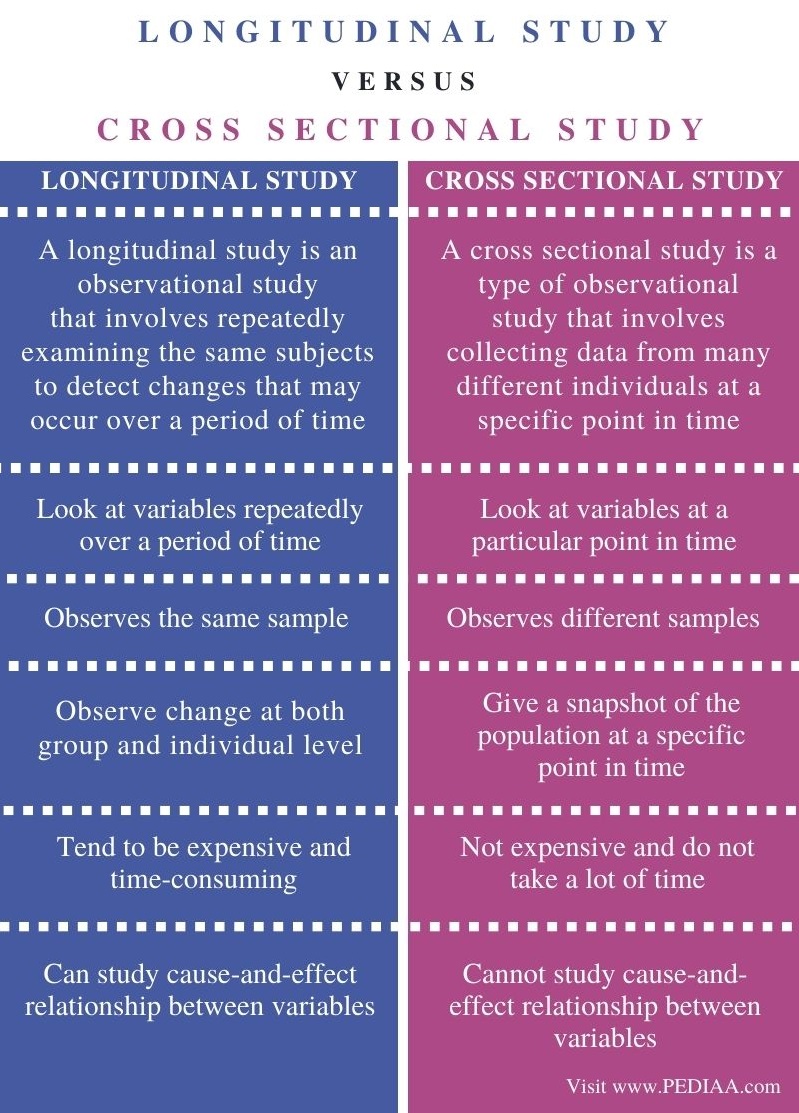Table Of Content

Longitudinal studies tend to be challenging to conduct because large samples are needed for any relationships or patterns to be meaningful. Longitudinal studies can take months or years to complete, rendering them expensive and time-consuming. Because of this, researchers tend to have difficulty recruiting participants, leading to smaller sample sizes. Participants sometimes drop out of a study for any number of reasons, like moving away from the area, illness, or simply losing motivation. This tendency, known as selective attrition, shrinks the sample size and decreases the amount of data collected.
Advantages of Longitudinal Studies

The Minnesota twin study was a longitudinal study that set out to find an answer to this question by studying a group of twins from 1979 to 1990 under the supervision of Thomas J Bouchard. Conducting a longitudinal study with surveys is straightforward and applicable to almost any discipline. Additional data points can be collected to study unexpected findings, allowing changes to be made to the survey based on the approach that is detected. When using this method, a longitudinal survey can pay off with actionable insights when you have the time to engage in a long-term research project.
Healthcare
Increased risk of asthma in patients with rheumatoid arthritis: A longitudinal follow-up study using a national sample ... - Nature.com
Increased risk of asthma in patients with rheumatoid arthritis: A longitudinal follow-up study using a national sample ....
Posted: Mon, 06 May 2019 07:00:00 GMT [source]
Longitudinal studies repeatedly observe the same sample population, while cross-sectional studies are conducted with different research samples. Longitudinal studies allow researchers to follow their subjects in real time. This means you can better establish the real sequence of events, allowing you insight into cause-and-effect relationships.
Famous Examples of Longitudinal Studies
The Framingham Heart study has given us invaluable data pertaining to the incidence of cardiovascular disease and further confirming a number of risk factors. The success of this study was further potentiated by the absence of treatments or modifiers, such as statin therapy and anti-hypertensives. This has enabled this study to more clearly delineate the natural history of this complex disease process. Irrespective of what study type you’d be conducting, you need a versatile data collection tool to help you accurately record your data. Collecting your own data is a more verifiable method because you can trust your own data.
Share this entry
Governmental and research institutes often carry out longitudinal studies and make the data available to the public. So you can pick up their previously researched data and use them for your own study. For example, let’s say you are researching social interactions among wild cats. You go ahead to recruit a set of newly-born lion cubs and study how they relate with each other as they grow.
Even if the study was created to study a specific pattern or characteristic, the data collection could show new data points or relationships that are unique and worth investigating further. In longitudinal studies, researchers do not manipulate any variables or interfere with the environment. Instead, they simply conduct observations on the same group of subjects over a period of time.
One key difference is that longitudinal studies follow the same sample of people over an extended period of time, while cross-sectional studies look at the characteristics of different populations at a given moment in time. Latent growth curve models allow researchers to model intraindividual change over time. For example, one could estimate parameters related to individuals’ baseline levels on some measure, linear or nonlinear trajectory of change over time, and variability around those growth parameters.
Disadvantages of longitudinal studies
You decide to study how a particular diet affects athletes’ performance over time. First, you gather your sample population, establish a baseline for the research, and observe and record the required data. So, he gathers a group of obese men and kicks off the systematic investigation using his preferred longitudinal study method.
Smart Surveys
Any divergence suggests inflated scores due to retesting rather than true change. Cohort effects occur when different cohorts show differing trajectories over time. Longitudinal studies will sometimes rely on surveys and questionnaires, which could result in inaccurate reporting as there is no way to verify the information presented. If the final group no longer reflects the original representative sample, attrition can threaten the validity of the experiment. Validity refers to whether or not a test or experiment accurately measures what it claims to measure.

At the time of its inception, the study aimed to study children who were exceptionally gifted in mathematics as evidenced from their Scholastic Aptitude Test (SAT) scores. The study found that identical twins who were reared apart in different environments did not display any greater chances of being different from each other than twins that were raised in the same environment. The latest installment was filmed in 2019 by which time the participants had reached 63 years of age. What we love about recurring surveys is the surprising results they can yield.
Longitudinal studies represent an examination of correlated phenomena over a period. Also, researchers find relevant information on how to write a longitudinal research design paper and learn about typical methodologies used for this research design. The chapter closes with referring to overlapping and adjacent research designs.
What makes retrospective studies longitudinal is simply the fact that they’re aimed at revealing trends over time. The one key difference between cohort studies and panel studies is that the same set of people has to be observed in the latter. In cohort studies, you can pick a different sample of the same demographic to study over time. Differences between retrospective and prospective cohort studies in definitions, examples, data collection, analysis, advantages, sample... Since longitudinal studies repeatedly observe subjects over a period of time, any potential insights from the study can take a while to be discovered. In a longitudinal study, researchers repeatedly examine the same individuals to detect any changes that might occur over a period of time.
It was discovered that intellectually gifted children had the same social skills and the same level of physical development as other children. The objective of the study at its commencement in 1921 was to study the life trajectories of exceptionally gifted children, as measured by standardized intelligence tests. The Terman Life-Cycle Study, also called the Genetic Studies of Genius, is one of the longest studies ever conducted in the field of psychology. In short, the results gleaned from the study (so far) strongly indicate that the quality of our relationships is one of the biggest factors in determining our quality of life.














